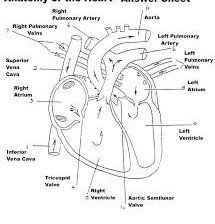More info
The majority of serious heart valve problems affect the mitral and aortic valves; disease of the tricuspid and pulmonary valves is fairly rare but more common in India, Pakistan and other developing countries than in North America or Western Europe.
Tricuspid regurgitation (TR) is more common than tricuspid stenosis and usually develops in association with pulmonary hypertension in patients with mitral stenosis or mitral regurgitation.
In tricuspid stenosis valve leaflets become thickened and undergo sclerosis with narrowing of the opening area of the valve.
This leads to enlargement of the right atrium and reduced flow into the ventricle. Blood flow into the pulmonary circulation is impaired and is accompanied by peripheral oedema and hepatomegaly.
Chronic rheumatic heart disease is usually the underlying cause and tricuspid stenosis is almost invariably associated with mitral valve disease.
Other causes include carcinoid syndrome, systemic lupus erythematosus, right atrial myxoma, congenital atresia or infiltrating tumours.
Tricuspid Regurgitation:
TR is more often secondary, rather than due to a primary valve lesion. Secondary TR is due to annular dilatation and increased tricuspid leaflet tethering in relation to right ventricular pressure overload (eg, pulmonary hypertension, cor pulmonale, idiopathic pulmonary arterial hypertension and/or volume overload (eg, atrial septal defect, intrinsic disease of the right ventricle).
Other causes include:
Rheumatic heart disease.
Infective endocarditis (eg, intravenous drug abuse).
Papillary muscle dysfunction (right ventricular infarction).
Following heart transplantation.
Carcinoid syndrome.
Rare congenital causes (including Ebstein's anomaly).
Iatrogenic causes include latent regurgitation unmasked following mitral valvotomy, and fenfluramine.
Management:
To manage tricuspid regurgitation it is important to rule out a primary cause.
Patients with mild TR do not require intervention.
Asymptomatic patients with severe primary TR should be followed carefully to detect progressive right ventricular enlargement and development of early right ventricular dysfunction. Surgery, if required, should be carried out early enough to avoid irreversible right ventricular dysfunction.
Tricuspid valve surgery is indicated in patients with severe TR. Tricuspid surgery should be considered in patients with moderate primary TR, as well as in patients with mild or moderate secondary TR and significant dilatation of the annulus.
Ring annuloplasty is currently favoured for severe TR related to isolated tricuspid annular dilatation.Better long-term results are seen with prosthetic rings than with the suture annuloplasty.
In more advanced forms of tethering and right ventricular dilatation, valve replacement should be considered. However, if technically possible, valve repair is preferable to valve replacement.
The need for correction of TR is usually considered at the time of surgical correction of associated left-sided valve lesions.
Reference:








